Black tea is the most popular tea in the world, and this is especially true of the Western world.
From “sweet tea” in the Southern United States, to English breakfast tea, to Assam black tea from India, there are dozens of ways to prepare black tea, and hundreds of unique varieties to choose from.
Whether you’re interested in exploring the centuries-old touted health benefits of black tea or exploring the wide-ranging flavor profile, it can be a little daunting to narrow down your options and figure out the best black tea.
We want to help you discover your favorite black tea, plus learn how to prepare it to ensure an authentic sipping experience!
What Does Black Tea Taste Like?
The flavors found in black teas include smoky, earthy, spicy, nutty, citrus, caramel, leather, fruity, and honey notes.
As opposed to green tea, which is light and grassy, black tea has a bolder, sweeter flavor. As with fine wines, many variables combine to give each black tea its own unique flavor profile.
These factors include the climate and elevation in which the Camellia sinensis plant was grown, how it was fertilized, the amount of oxidation allowed to occur during processing, how it was heat-treated to end the oxidation, and how the leaves were cut and packaged.
How to Choose the Best Black Tea
The best black tea will depend on your individual palate and preferences, but you can use these tips to discover your favorite:
- Brew it at the right temperature
- Steep for the proper amount of time
- Stick with organic, high-quality black teas
Compared to more delicate green and white teas, black teas require higher temperatures and longer steeping times. Insufficient heat or time results in a weak brew while overdoing it will lead to a bitter-tasting brew rich in tannins.
In general, you should steep black tea in hot water that’s 185-206 degrees Fahrenheit (85-96.5 degrees Celsius) for three to five minutes. In most cases, 206 degrees Fahrenheit is the appropriate temperature, but the steeping duration is up to you–longer will make your tea taste stronger.
And remember: bagged black tea from the grocery store shelf isn’t going to be the best black tea! The tiny black tea bags don’t allow flavors to fully develop while steeping, plus they usually contain low-quality, machine-processed black tea.
For the very best black tea experience, you’ll want to try premium organic loose leaf teas, or you can also try tea crystals for a convenient option that doesn’t compromise on quality.
The 11 Best Black Teas From Around the World
- English Breakfast Tea
- Earl Grey
- Assam Black Tea
- Yunnan Black Tea
- Darjeeling Black Tea
- Keemun Black Tea
- Ceylon Black Tea
- Lapsang Souchong
- Nilgiri
- Hei Cha
- Masala Chai
1. English Breakfast Tea
Drinking a blend of strong black teas for breakfast is a British custom. The tradition got its start sometime in the mid-19th century, but it really took off when Queen Victoria began hoarding her own stash in the 1890s!
The precise selection of black teas used in breakfast tea blends can vary greatly, but popular choices include Assam, Ceylon, and Kenyan black teas. More expensive varieties often use Keemun black tea from China.
English breakfast tea is meant to be brewed strong. It’s full-bodied, robust, and rich, and–as is the custom in England–goes well with milk and sweetener.
Try steeping English breakfast tea for a full five minutes at 206 degrees Fahrenheit (96.5 degrees Celsius).
Pique English Breakfast Black Tea
Cornerstone of an enlivened morning. Harmonious balance for your gut bugs.
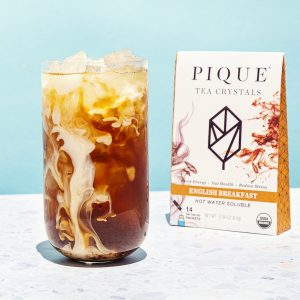
2. Earl Grey
Earl Grey is another world-famous tea that first became popular in England. In the 1830s, Charles Grey, the British Prime Minister, is said to have received a gift of black tea scented with bergamot oil from a Chinese envoy.
Bergamot orange (Citrus bergamia) is a small citrus tree with winter blossoms that grows primarily in Calabria, Italy. The oil of bergamot lends a bright, delicate, floral-tinged citrusy taste that complements the bold and assertive character of the black tea.
Many commercial varieties today use artificial flavors instead of real bergamot. If you want to try authentic Earl Grey, stick with high-quality, organic blends that only use natural flavors.
Pique Earl Grey Black Tea
A swift, steady infusion of energy. Citrus bergamot to delight your senses and cells.
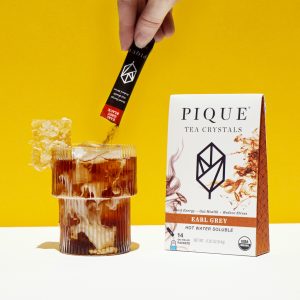
3. Assam Black Tea
Assam black tea is named after the region of Assam, India.
In the 1830s, British business interests saw the opportunity to compete with Chinese tea makers, so they shifted British tea production to India. From that point onward, Assam became the world’s largest tea-producing region.
Assam black tea grows mostly at or near sea level. The tropical climate and large amount of rainfall result in a unique, chocolaty finish to this black tea variety. It is also known for its full body, briskness, malty notes, and strong color.
You can drink Assamese teas black, or add honey and a splash of nut milk.
4. Yunnan Black Tea
Yunnan black tea originates in Yunnan Province, China. In that region, Yunnanese teas are known as Dianhong.
One thing that sets Dianhong apart from most other black teas is that it has a high concentration of the delicate leaf buds known as “golden tips.”
This type of black tea is rich and smooth, with hints of chocolate, honey, and pepper.
Unlike most black teas, Yunnan black tea produces a brassy orange brew instead of the brown or black color to which you may be accustomed.
5. Darjeeling Black Tea
Darjeeling tea is only found in the high, mountainous town of Darjeeling, India. Some people call Darjeeling black tea the “champagne of tea” for its delicate, fruity, floral notes.
The character of this black tea, however, can vary depending on when it’s harvested. Each of the four annual harvests, called a “flush” in the tea industry, has its own character.
The spring flush has a grassy, green taste. It’s the most sought-after harvest of Darjeeling tea. The summer or second flush, which occurs in June, has a fruity, spicy character, while the later flushes have a stronger flavor with more bitter tannins.
Darjeeling black tea is best served as-is, without added milk or sugar.
6. Keemun Black Tea
Keemun is a special variety of black tea grown in the Anhui Province of eastern China. It’s also known as Qimen Hongcha. Compared to other black teas, this type is dried and oxidized over a longer period of time.
Connoisseurs seek Keemun for its smooth, complex aroma and flavor, which includes notes of fruit, flowers, pine, tobacco, and unsweetened cacao.
You can enjoy it plain, or with limited quantities of nut milk and honey.
Brew Keemun black tea at 190-194 degrees Fahrenheit (87.5-90 degrees Celsius) for two to five minutes.
7. Ceylon Black Tea
Ceylon teas are produced on the island nation that’s now known as Sri Lanka. When Sri Lankan tea production first reached international fame in the early 19th century under British rule, Sri Lanka was called Ceylon, and the colonial name has stuck for tea production ever since.
Sri Lanka has an incredible range of different altitudes and terroirs, so their tea plantations produce a wide variety of flavor profiles.
Low-elevation Ceylon black tea leaves have a strong, spicy flavor and produce a burgundy-brown brew, while higher-elevation varieties offer more delicate, nuanced flavor profiles and result in a deep black tea.
Generally speaking, Ceylon black tea is bold enough to handle the addition of nut milk, lemon, or honey. It’s also a fantastic choice for iced tea.
8. Lapsang Souchong
Lapsang Souchong originates exclusively from the high Wuyi mountains of Fujian Province on the southeast coast of mainland China.
Unlike other black teas, Lapsang Souchong is a smoked tea. It’s dried over burning pine fires, imbuing the leaves with a unique, smoky flavor and fragrance.
If you like bold flavors like charcuterie, dark-roasted coffee, and unsweetened chocolate, you’ll appreciate the smoky, piney notes of Lapsang Souchong. It’s sometimes called the “whiskey of tea.”
Enjoy this black tea hot, with a little bit of honey and lemon if you want to cut the smoky flavor slightly. It’s also an excellent choice for making iced tea.
9. Nilgiri
Nilgiri tea, also called Blue Mountain tea, is grown in small crops on the Western Ghats mountains in Southern India. These teas are some of the highest-elevation teas in the entire world, with many farms over 8,000 feet above sea level.
Black teas of the Nilgiri variety are fragrant, slightly sweet, medium-bodied, and contain hints of fruit.
Steep Nilgiri black tea between 200-212 degrees Fahrenheit (93.5-100 degrees Celsius) for two to three minutes and serve it immediately.
10. Hei Cha
Hei Cha is a special type of Chinese tea. The literal meaning of Hei Cha is “black tea,” but it’s different from Western black teas because it’s fermented under special conditions to develop complex, intricate flavors not typically found in black teas.
According to legend, Hei Cha was invented when tea caravans on the silk road encountered wet conditions that soaked their cargo. Their first impulse was to discard the “ruined” tea, but they soon discovered it had flavors and health benefits that set it apart from other teas.
Hei Cha black tea contains aromas and flavors that range from piney to “marine” (think seaweed), fungal, “mushroomy,” or loamy.
Steep Hei Cha between 200 and 210 degrees Fahrenheit (93.5-99 degrees Celsius) for three to four minutes.
11. Masala Chai
Masala chai (literally “mixed-spice tea”) dates back thousands of years in the Indian Ayurvedic tradition.
Most Masala chai contains a blend of delicate Assam black tea with cinnamon, cloves, cardamom, ginger, and black pepper. Sometimes it also includes other spices like anise or nutmeg.
Steep chai between 200-212 degrees Fahrenheit (93.5-99 degrees Celsius) for three to five minutes. Nut milk or honey can help balance the vivid flavors of this blend.
Final Thoughts on the Best Black Teas
Black tea is popular around the world, and rightly so. Thanks to its rich history, full-body, and enticing aroma, there’s nothing that can take its place.
There’s a black tea out there for everyone. If you’re on a quest to discover your favorite, remember to stick with fair-trade, high-quality, USDA organic loose-leaf tea or tea crystals.


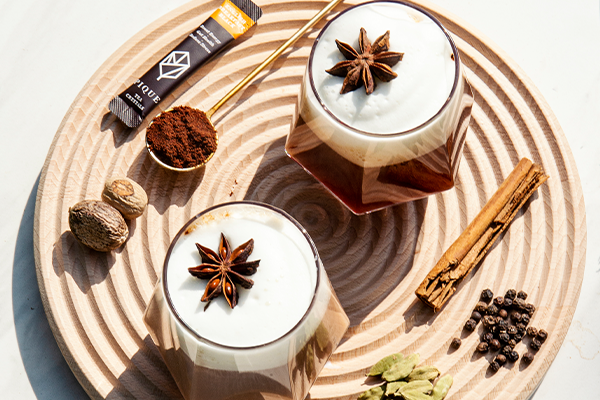
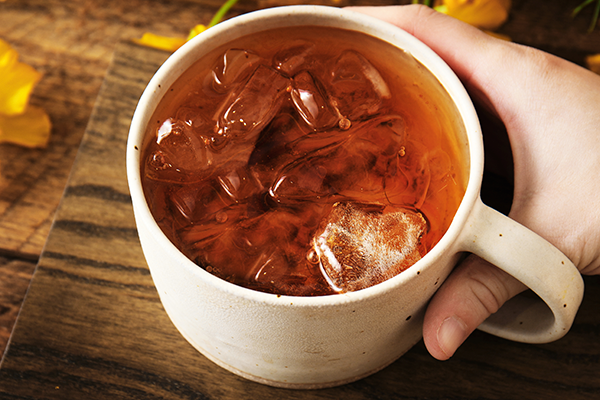
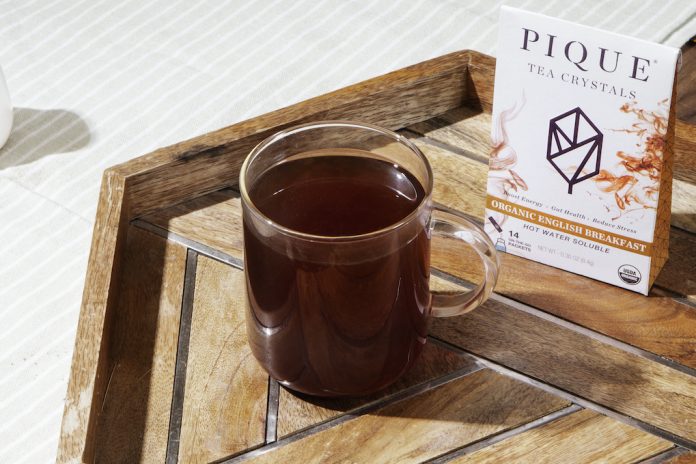
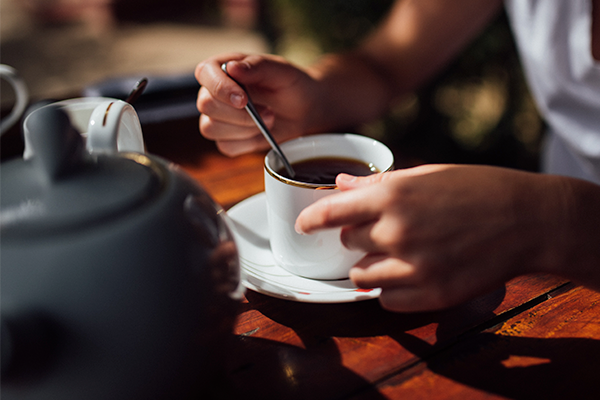
Ah come! Dian Hong is amazing tea, the taste is like honey.
Best one I’ve tried so far!